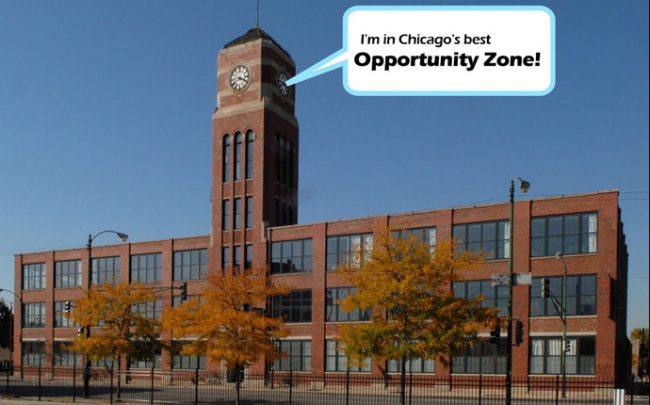The federal Opportunity Zones program was not designed to help people like Phil Denny.

Peppercorn Capital founder Phil Denny
But the first time Denny saw the state-issued map of the zones, which crack open a collection of tax breaks for investors who buy property in distressed areas, the prolific West Loop property owner immediately started making phone calls.
The 8,700 American Census tracts designated as Opportunity Zones include a quarter-square-mile rectangle on the Near West Side where Peppercorn Capital, Denny’s development firm, owns nine properties with some 650,000 square feet of vacant land.
“I may not always be the smartest guy in the room, but I’m certainly the luckiest,” Denny said. “I don’t know how I managed to amass so much property inside an Opportunity Zone … but if the rising tide lifts all boats, I’m going to leverage my ownership of those sites the best I can.”
The tract, which faces Fulton Market at one end and the soon-to-be-built Damen Avenue Green Line station on the other, is one of handful of areas in Chicago where Opportunity Zones are poised to turbo-charge ambitious redevelopment plans already on the books.
Even as investors wait for federal regulators to fill in some details of the program’s rules, financial managers from coast to coast have been racing to channel billions of dollars into Qualified Opportunity Funds so they can maximize their returns before benefits expire in 2026. One fund, from Chicago-based Origin Investments, raised more than $100 million in less than a day.
The 140 eligible Census tracts in Chicago trace a familiar map of low-income areas on the South and West sides, including the majority of the land in neighborhoods like Englewood, Grand Crossing and West Garfield Park.
But it might be years before Opportunity Zone investments make their way to the city’s poorest neighborhoods, if ever. Investors’ rush to place their bets means they’re unlikely to look past areas already seen as viable targets for development, according to Adam Southard, managing director of Savills Studley’s Chicago office.
Opportunity Zones “could have a benefit on the margin, where if you have a project that’s close to making sense, this gets it there,” Southard said. “But you mostly have operators who would have been looking for opportunities in these areas anyway, and now there’s just a larger pool of capital being directed at them.”
Michael Reese and Bronzeville
The program is almost certain to boost Farpoint Development and McLaurin Development’s unreleased plan for the 49-acre former Michael Reese Hospital site, located inside an anvil-shaped Opportunity Zone that stretches from Motor Row to 31st Street Beach on the Near South Side.
That stretch also includes the former site of the Harold L. Ickes Homes, where McCaffery Interests and Community Builders are planning a 900-unit mixed-income redevelopment they’re calling Southbridge. Community Builders is “examining” Opportunity Funds as a potential source of financing for the development, a spokesperson said.
McLaurin principal Zeb McLaurin declined to say how Opportunity Zone investment could impact the firms’ “Burnham Lakefront” vision for the Michael Reese site, which they’re still negotiating to buy from the city. But the developer is reaping the program’s benefits on a string of other projects he’s planning in Bronzeville, where about a dozen Opportunity Zone census tracts overlay a rapidly-transitioning landscape, he said.
“At this point in the development cycle, it’s created a largesse of opportunity for different capital sources that we may not have been considered in the past,” McLaurin said. “And the more investment-grade resources you can bring into these areas, it’s a net positive for all.”
Michael Lucas, McLuarin’s director of investor relations, added the extra financing stream is bound to cascade through other parts of the neighborhood. But it could lead investors to overstretch, he added.
“Any time you have a ton of money rushing in like this, we know that fools rush in, too,” Lucas said. “When these funds start to get deployed, you’re probably going to get a lot of money chasing things without any art.”
UIC and the Medical District
Opportunity Fund managers are also fixing their attention on a narrow strip of Opportunity Zone tracts on the Near West Side that reach from Racine Avenue in University Village to the edge of Douglas Park.
That stretch includes CityPads’ planned 223-bed Common Addams co-living space near Addams/Medill Park, as well as the Habitat Company’s 10-acre Ogden Commons mixed-use campus, which the Chicago Plan Commission approved earlier this month.
Habitat had been preparing to chase down a patchwork of tax credits to help fund the development, president Matt Fiascone said. The firm will stick to its original funding plan for the 332-unit residential portion of the development, but it will look for an Opportunity Fund to front about half the projected cost of the retail and office components.
“This creates a whole lot of capital that wouldn’t have been there otherwise, because the tax benefits mean investors are willing to take a lower absolute return,” Fiascone said. “The financing would still have been there (without Opportunity Zones), it just would have been more complicated and required much more effort on our part.”
The extra funding stream won’t push Fiascone to scale up the development or quicken its construction timeline, but he anticipates being able to select from an especially long line of potential retail tenants who could catch a piece of the tax benefits, he said.
Kinzie Industrial Corridor
Denny has dedicated the past two months of his life to learning everything there is to know about Opportunity Zones, he said.
Now he’s waging a full-scale marketing campaign, leaning on the daily hoopla around the tax incentive to get investors on board with new office incubators and coworking spaces inside the 24-square-block zone.

Crate & Barrel headquarters at 240 North Ashland Avenue
He’s also preparing to sell the Crate & Barrel headquarters at 240 North Ashland Avenue, a three-story brick office complex with a clock tower overlooking Union Park. He published a listing on CoStar showing a photo of the industrial-era building with a cartoon speech bubble poking out from it: “I’m in Chicago’s best Opportunity Zone!”
“I’ve owned the building for 10 years, and this Opportunity Zone has created the chance for me to test the market based on all the interest that’s been pouring in,” Denny said. “It’s a testament to the fact that maybe this area shouldn’t have been an Opportunity Zone in the first place.”
The zone is part of a Planned Manufacturing District called the Kinzie Industrial Corridor, which city planners have proposed amending so retail and office tenants can open businesses there.
But the proposed change wouldn’t bump up the area’s relatively low-density zoning, which could make it rocky ground for development, according to one person close to development in the area who requested anonymity to speak to The Real Deal.
“If a deal makes economic sense west of Ogden, then you can bring that deal to fruition,” the person said. “But I think property owners may start to get greedy because they think it’s a gold rush like Fulton Market, and they’ll start overcharging for the cost of land. It can work for creative office space, but since it won’t have a high-rise class-A office feel, you won’t get some of those big deal office tenants.”
